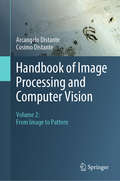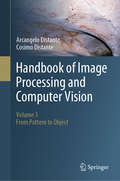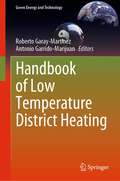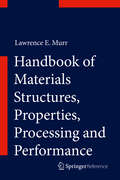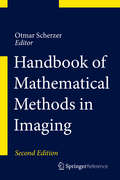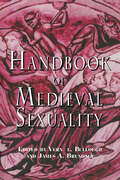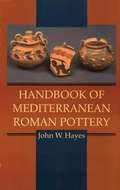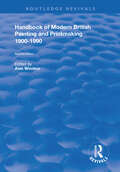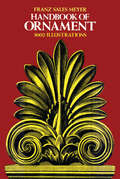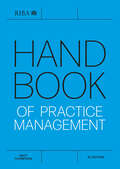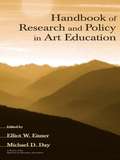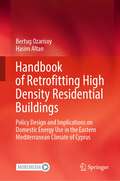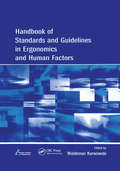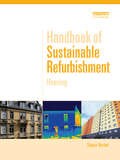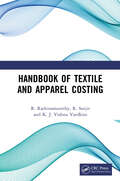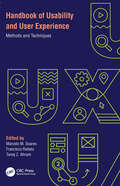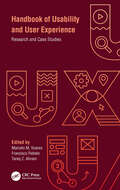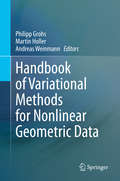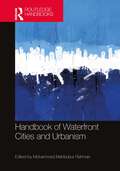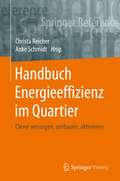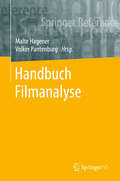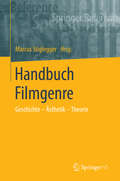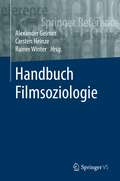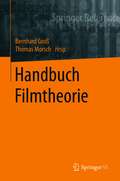- Table View
- List View
Handbook of Image Processing and Computer Vision: Volume 2: From Image to Pattern
by Cosimo Distante Arcangelo DistanteAcross three volumes, the Handbook of Image Processing and Computer Vision presents a comprehensive review of the full range of topics that comprise the field of computer vision, from the acquisition of signals and formation of images, to learning techniques for scene understanding. The authoritative insights presented within cover all aspects of the sensory subsystem required by an intelligent system to perceive the environment and act autonomously. Volume 2 (From Image to Pattern) examines image transforms, image restoration, and image segmentation.Topics and features:• Describes the fundamental processes in the field of artificial vision that enable the formation of digital images from light energy• Covers light propagation, color perception, optical systems, and the analog-to-digital conversion of the signal• Discusses the information recorded in a digital image, and the image processing algorithms that can improve the visual qualities of the image• Reviews boundary extraction algorithms, key linear and geometric transformations, and techniques for image restoration• Presents a selection of different image segmentation algorithms, and of widely-used algorithms for the automatic detection of points of interest• Examines important algorithms for object recognition, texture analysis, 3D reconstruction, motion analysis, and camera calibration• Provides an introduction to four significant types of neural network, namely RBF, SOM, Hopfield, and deep neural networksThis all-encompassing survey offers a complete reference for all students, researchers, and practitioners involved in developing intelligent machine vision systems. The work is also an invaluable resource for professionals within the IT/software and electronics industries involved in machine vision, imaging, and artificial intelligence.Dr. Cosimo Distante is a Research Scientist in Computer Vision and Pattern Recognition in the Institute of Applied Sciences and Intelligent Systems (ISAI) at the Italian National Research Council (CNR). Dr. Arcangelo Distante is a researcher and the former Director of the Institute of Intelligent Systems for Automation (ISSIA) at the CNR. His research interests are in the fields of Computer Vision, Pattern Recognition, Machine Learning, and Neural Computation.
Handbook of Image Processing and Computer Vision: Volume 3: From Pattern to Object
by Cosimo Distante Arcangelo DistanteAcross three volumes, the Handbook of Image Processing and Computer Vision presents a comprehensive review of the full range of topics that comprise the field of computer vision, from the acquisition of signals and formation of images, to learning techniques for scene understanding. The authoritative insights presented within cover all aspects of the sensory subsystem required by an intelligent system to perceive the environment and act autonomously. Volume 3 (From Pattern to Object) examines object recognition, neural networks, motion analysis, and 3D reconstruction of a scene.Topics and features:• Describes the fundamental processes in the field of artificial vision that enable the formation of digital images from light energy• Covers light propagation, color perception, optical systems, and the analog-to-digital conversion of the signal• Discusses the information recorded in a digital image, and the image processing algorithms that can improve the visual qualities of the image• Reviews boundary extraction algorithms, key linear and geometric transformations, and techniques for image restoration• Presents a selection of different image segmentation algorithms, and of widely-used algorithms for the automatic detection of points of interest• Examines important algorithms for object recognition, texture analysis, 3D reconstruction, motion analysis, and camera calibration• Provides an introduction to four significant types of neural network, namely RBF, SOM, Hopfield, and deep neural networksThis all-encompassing survey offers a complete reference for all students, researchers, and practitioners involved in developing intelligent machine vision systems. The work is also an invaluable resource for professionals within the IT/software and electronics industries involved in machine vision, imaging, and artificial intelligence.Dr. Cosimo Distante is a Research Scientist in Computer Vision and Pattern Recognition in the Institute of Applied Sciences and Intelligent Systems (ISAI) at the Italian National Research Council (CNR). Dr. Arcangelo Distante is a researcher and the former Director of the Institute of Intelligent Systems for Automation (ISSIA) at the CNR. His research interests are in the fields of Computer Vision, Pattern Recognition, Machine Learning, and Neural Computation.
Handbook of Low Temperature District Heating (Green Energy and Technology)
by Roberto Garay-Martinez Antonio Garrido-MarijuanThis book reviews the history and evolution of district heating networks, with a focus on current and future issues of the district heating sector. Novel developments in the field of low temperature district heating are studied, limitations for safe operation and avoidance of bacteria are considered, and the associated improved performance of the system with fewer network losses is presented.This book showcases how the evolution of district heating networks is linked to the increased use of renewables and de-carbonized heat sources with specific focus to waste heat streams and solar energy systems. Considering the novelty of these technologies, technological developments and funding schemes for these investments are still immature to some extent. For that reason, a comprehensive review of the main aspects of energy planning as well as district heating economics and financing schemes for large-scale investments in renewable energy systems for district energy systems is performed.In the light of digitalization, networks are increasingly monitored, allowing for a drastic change in the approach for network operation. This book also explores the increased digitization and monitoring of networks and how this impacts network operation.This book is of interest to engineers, academics and officials interested in energy systems, presenting readers with the key concepts and tools to adapt to the evolution of district heating into an integrated, digitized and higher performing system.
Handbook of Materials Structures, Properties, Processing and Performance
by Lawrence E. MurrThis extensive knowledge base provides a coherent description of advanced topics in materials science and engineering with an interdisciplinary/multidisciplinary approach. The book incorporates a historical account of critical developments and the evolution of materials fundamentals, providing an important perspective for materials innovations, including advances in processing, selection, characterization, and service life prediction. It includes the perspectives of materials chemistry, materials physics, engineering design, and biological materials as these relate to crystals, crystal defects, and natural and biological materials hierarchies, from the atomic and molecular to the macroscopic, and emphasizing natural and man-made composites. This expansive presentation of topics explores interrelationships among properties, processing, and synthesis (historic and contemporary). The book serves as both an authoritative reference and roadmap of advanced materials concepts for practitioners, graduate-level students, and faculty coming from a range of disciplines.
Handbook of Mathematical Methods in Imaging
by Otmar ScherzerThe Handbook of Mathematical Methods in Imaging provides a comprehensive treatment of the mathematical techniques used in imaging science. The material is grouped into two central themes, namely, Inverse Problems (Algorithmic Reconstruction) and Signal and Image Processing. Each section within the themes covers applications (modeling), mathematics, numerical methods (using a case example) and open questions. Written by experts in the area, the presentation is mathematically rigorous. The entries are cross-referenced for easy navigation through connected topics. Available in both print and electronic forms, the handbook is enhanced by more than 150 illustrations and an extended bibliography. It will benefit students, scientists and researchers in applied mathematics. Engineers and computer scientists working in imaging will also find this handbook useful.
Handbook of Medieval Sexuality (Reference Library Of The Humanities #Vol. 1696)
by James A. Brundage Vern L. BulloughLike specialists in other fields in humanities and social sciences, medievalists have begun to investigate and write about sex and related topics such as courtship, concubinage, divorce, marriage, prostitution, and child rearing. The scholarship in this significant volume asserts that sexual conduct formed a crucial role in the lives, thoughts, hopes and fears both of individuals and of the institutions that they created in the middle ages.The absorbing subject of sexuality in the Middle Ages is examined in 19 original articles written specifically for this "Handbook" by the major authorities in their scholarly specialties. The study of medieval sexuality poses problems for the researcher: indices in standard sources rarely refer to sexual topics, and standard secondary sources often ignore the material or say little about it. Yet a vast amount of research is available, and the information is accessible to the student who knows where to look and what to look for. This volume is a valuable guide to the material and an indicator of what subjects are likely to yield fresh scholarly rewards.
Handbook of Mediterranean Roman Pottery
by John W. HayesIn the past, Roman pottery has been judged as inferior to Greek pottery. Recent excavations, however, have led to an increase in knowledge and appreciation of Roman wares. These wares now constitute an important body of evidence for the understanding of art, literacy and trade in the ancient world. John W. Hayes, the acknowledged authority in this field, explains the particular features that mark Roman-period wares, concisely describing how the vessels were manufactured, decorated, traded and used. Placing the pottery in historical context, he describes its roots in the Hellenistic Greek tradition, its evolution as a distinct art form and its influence on Byzantine and Islamic trends.
Handbook of Modern British Painting and Printmaking 1900-90 (Routledge Revivals)
by Alan WindsorOriginally published in 1998, The Handbook of Modern British Painting and Printmaking 1900-1990 has been designed for people who enjoy, study and buy British art. The only portable dictionary-style guide to the life and work of modern British painters and printmakers, the book provides information on some 2,000 artists, as well as entries on schools of art, on museums, galleries and collections, on societies and groups, and critics and patrons who have influenced the development of modern art in Britain. Compiled by scholars, the entries are cross-referenced and each concise biographical outline provides the relevant facts about the artist's life, a brief characterisation of the artist's work, and major bibliographic references. Wherever possible, one or two suggestions for further reading are cited.
Handbook of Ornament: A Grammar Of Art, Industrial And Architectural Designing In All Its Branches, For Practical As Well As Theoretical Use (classic Reprint) (Dover Pictorial Archive Ser.)
by Franz Sales MeyerRepublished unabridged from the final comprehensive edition, this work contains the largest single-volume collection of classical art motifs ever compiled. It reproduces material from Greek and Roman, medieval European, Islamic, Renaissance, baroque, and early nineteenth-century art, architecture, and design — in all, presenting artists, crafters, and students with more than 3,000 designs.Featured design elements include networks, Gothic tracery, geometric designs, akanthos leaves, lotus ornamentation, animal ornamentation, grotesque figures, fret bands, chains, interlacements, rosettes, undulations, spirals, link borders, cresting borders, finials, crockets, gargoyles, foliations, panels, repeated ornaments, and hundreds of other elements. Other plates show decorated pottery vases, religious utensils, weapons, furniture, lamps, jewelry, and other artifacts, in addition to heraldic motifs and ornamental letters.
Handbook of Practice Management
by Matt ThompsonSeeking advice on practice management? This new edition of RIBA’s (Royal Institute of British Architects) classic handbook brings guidance right up to date. It covers the full deck of management competencies, including how to run your finances, win work, employ people, operate your office, handle information, assure quality, and manage your risks.In print for 50 years, this enduring reference book has been comprehensively restructured and modernised to reflect the latest changes in practice. Aimed at those who are already managing a design studio or setting up a practice, it provides advice on all aspects of practising architecture in the UK and is a core reference book for practitioners and students alike.Divided into two parts, the first characterises and quantifies the business of designing buildings in the context of the construction industry. It outlines what it means to be a member of the architect profession and considers the trends that seem likely to influence its future direction.The second part sets out the overlapping activities that together constitute practice management. A chapter on business strategy is followed by seven topic-specific chapters organised to: Distinguish between what you must do by law, what you should do to conform to professional codes of conduct, and what you might do to compete in the market Outline the most important management considerations Highlight the tactics and tools available to you Signpost useful resources and sources of more detailed information. A must-have handbook for chartered members of RIBA (Royal Institute of British Architects) and ARB (Architects Registration Board) registered architects. The guidance accounts for architects’ duties under ARB’s Architects Code; and chartered members’ duties under the RIBA Code of Professional Conduct and chartered practices’ duties under the RIBA Code of Professional Practice.
Handbook of Research and Policy in Art Education
by Elliot W. Eisner Michael D. DayThe Handbook of Research and Policy in Art Education marks a milestone in the field of art education. Sponsored by the National Art Education Association and assembled by an internationally known group of art educators, this 36-chapter handbook provides an overview of the remarkable progress that has characterized this field in recent decades. Organized into six sections, it profiles and integrates the following elements of this rapidly emerging field: history, policy, learning, curriculum and instruction, assessment, and competing perspectives. Because the scholarly foundations of art education are relatively new and loosely coupled, this handbook provides researchers, students, and policymakers (both inside and outside the field) an invaluable snapshot of its current boundaries and rapidly growing content. In a nutshell, it provides much needed definition and intellectual respectability to a field that as recently as 1960 was more firmly rooted in the world of arts and crafts than in scholarly research.
Handbook of Retrofitting High Density Residential Buildings: Policy Design and Implications on Domestic Energy Use in the Eastern Mediterranean Climate of Cyprus
by Bertug Ozarisoy Hasim AltanThis book investigates energy use and measures to improve the energy efficiency of public housing, using post-war social housing development estates in Cyprus as its example. On this Mediterranean island, which experiences hot and humid temperatures throughout the year, residential buildings need to adapt to the climate to improve the thermal comfort of their occupants. The book assesses the domestic energy use of inefficiently built residential tower blocks and their occupants’ thermal comfort by considering the significant impact of overheating risks on energy consumption and occupants’ thermal comfort and well-being, with the intention of evaluating the current energy performance of base-case representative residential tower blocks (RTBs). In particular, considering the cooling energy demand in the summer, using Famagusta, Cyprus as a case study. It seeks to identify the impact of occupancy patterns and habitual adaptive behaviour of households on home energy performance in order to provide bases for the information needed to calibrate building energy performance of targeted households.
Handbook of Standards and Guidelines in Ergonomics and Human Factors
by Waldema KarwowskiA comprehensive review of international and national standards and guidelines, this handbook consists of 32 chapters divided into nine sections that cover standardization efforts, anthropometry and working postures, designing manual material, human-computer interaction, occupational health and safety, legal protection, military human factor standar
Handbook of Sustainable Refurbishment: Housing
by Simon BurtonBased on careful analysis and experience in all housing sectors and house types, this handbook explains and demonstrates how to incorporate the most effective energy saving measures in the existing housing stock.It begins by setting out the basic aims of sustainable refurbishment before presenting a large number of illustrated case studies from a range of single- and multi-family dwellings. A practical section then details the specific measures that can be taken to reduce the energy demand of buildings, with extensive references to further resources. Written for architects and building engineers, the book combines technical and managerial solutions demonstrating that a new refurbishment culture needs to be created that radically improves the energy performance of all existing houses whenever any opportunity presents itself and whenever any work is carried out.
Handbook of Textile and Apparel Costing
by R. Rathinamoorthy R. Surjit K. J. VardhiniHandbook of Textile and Apparel Costing covers a wider area of the costing aspects of industrial and academic requirements from spinning to the apparel sector.It is a one of its kind in the textile and fashion discipline that covers the cost calculation methods of every manufacturing step in entirety: spinning, weaving, processing, and apparel manufacturing.Print edition not for sale in South Asia (Bangladesh, Bhutan, India, Nepal, Pakistan and Sri Lanka)
Handbook of Usability and User-Experience: Methods and Techniques
by Marcelo M. Soares, Francisco Rebelo and Tareq Z. AhramHandbook of Usability and User Experience: Methods and Techniques is concerned with emerging usability and user experience in design concepts, theories and applications of human factors knowledge focusing on the discovery, design and understanding of human interaction and usability issues with products and systems for their improvement. This volume presents methods and techniques to design products, systems and environments with good usability, accessibility and user satisfaction. It introduces the concepts of usability and its association with user experience, and discusses methods and models for usability and UX. It also introduces relevant cognitive, cultural, social and experiential individual differences, which are essential for understanding, measuring and utilizing these differences in the study of usability and interaction design. In addition, the book discusses the use of usability assessment to improve healthcare, the relationship between usability and user experience in the built environment, the state-of-the-art review of usability and UX in the digital world, usability and UX in the current context, and emerging technologies. We hope that this first of two volumes will be helpful to a large number of professionals, students and practitioners who strive to incorporate usability and user experience principles and knowledge in a variety of applications. We trust that the knowledge presented in this volume will ultimately lead to an increased appreciation of the benefits of usability and incorporate the principles of usability and user experience knowledge to improve the quality, effectiveness and efficiency of consumer products, systems and environments in which we live.
Handbook of Usability and User-Experience: Research and Case Studies
by Marcelo M. Soares, Francisco Rebelo and Tareq Z. AhramThis volume of the Handbook of Usability and User Experience (UX) presents research and case studies used to design products, systems and environments with good usability and consequent acceptance, pleasure in use, good user experience, and understanding of human interaction issues with products and systems for their improvement. The book presents concepts and perspectives of UX; it also discusses methods and tools that use requirements analysis activity elicitation, recording, and analysis to guarantee a good user experience. In addition, it introduces usability and UX in the automotive industry, usability and UX in a digital interface, game design and digital media, usability and UX in fashion design, and some case studies on usability and UX in various contexts in product design. We hope that this second volume will be helpful to a larger number of professionals, students and practitioners who strive to incorporate usability and UX principles and knowledge in a variety of applications. We trust that the knowledge presented in this volume will ultimately lead to an increased appreciation of the benefits of usability and incorporate the principles of usability and UX knowledge to improve the quality, effectiveness, and efficiency of everyday consumer products, systems, and environments.
Handbook of Variational Methods for Nonlinear Geometric Data
by Philipp Grohs Martin Holler Andreas WeinmannThis book covers different, current research directions in the context of variational methods for non-linear geometric data. Each chapter is authored by leading experts in the respective discipline and provides an introduction, an overview and a description of the current state of the art. Non-linear geometric data arises in various applications in science and engineering. Examples of nonlinear data spaces are diverse and include, for instance, nonlinear spaces of matrices, spaces of curves, shapes as well as manifolds of probability measures. Applications can be found in biology, medicine, product engineering, geography and computer vision for instance. Variational methods on the other hand have evolved to being amongst the most powerful tools for applied mathematics. They involve techniques from various branches of mathematics such as statistics, modeling, optimization, numerical mathematics and analysis. The vast majority of research on variational methods, however, is focused on data in linear spaces. Variational methods for non-linear data is currently an emerging research topic. As a result, and since such methods involve various branches of mathematics, there is a plethora of different, recent approaches dealing with different aspects of variational methods for nonlinear geometric data. Research results are rather scattered and appear in journals of different mathematical communities. The main purpose of the book is to account for that by providing, for the first time, a comprehensive collection of different research directions and existing approaches in this context. It is organized in a way that leading researchers from the different fields provide an introductory overview of recent research directions in their respective discipline. As such, the book is a unique reference work for both newcomers in the field of variational methods for non-linear geometric data, as well as for established experts that aim at to exploit new research directions or collaborations.Chapter 9 of this book is available open access under a CC BY 4.0 license at link.springer.com.
Handbook of Waterfront Cities and Urbanism
by Mohammed Mahbubur RahmanHandbook of Waterfront Cities and Urbanism is the first resource to address cities’ transformations of their coastlines and riverbanks and the resulting effects on environment, culture, and identity in a genuinely global context. Spanning cities from Gdańsk to Georgetown, this reference for design, development, and planning explores the transition of waterfronts from industrial and port zones to crowd-drawing urban spectacles within the frameworks of urban development, economics, ecology, governance, globalization, preservation, and sustainability. A collection of contextual studies, local perspectives, project reviews, and analyses of evolution and emerging trends provides critical insight into the phenomenon of waterfront development and urbanism in cities from the East to the West. Features: Explores the transformation of waterfronts from industrial hubs to urban playgrounds through the lenses of preservation, governance, economics, ecology, and more. Presents chapter-length case studies drawn from cities in China, Bangladesh, Turkey, the United States, Malaysia, the European Union, Egypt, and other countries. Includes contributions from an interdisciplinary team of international scholars and professionals, a much-needed corrective to the historical exclusion of researchers and issues from the Global South. An ideal reference for graduate students, scholars, and professionals in urban planning, architecture, geography, and history, the Handbook of Waterfront Cities and Urbanism deserves to be on the shelf of urban authorities and any internationally minded academic or practitioner in real estate development, water management, preservation, or tourism.
Handbuch Brettspiele: Tätigkeiten und Akteure in der Brettspielbranche
by Jürgen Karla Christoph PostIm Rahmen einer Podcast-Reihe im Jahr 2021 wurde die Entstehung eines Brettspiels - Von der Idee zum fertigen Produkt betrachtet. Im Rahmen dieses Herausgeberbandes erfolgt nun eine schriftliche Dokumentation durch Expertinnen und Experten aus der Brettspielbranche. Einleitend erfolgt eine Darstellung der Branche und der Branchenstrukturen orientiert an den Netzwerkstrukturen moderner Wertschöpfung. Bekannte Autorinnen und Autoren erläutern Ihre Vorgehensweisen zur Entwicklung von Brettspiel-Ideen und deren Weiterleitung an die Redaktionen in Verlagen. Führende Experten aus verschiedensten Aufgabengebieten in Verlagen stellen Ihre Aufgabenbereiche vor und erläutern die Prozesse in der Entstehung von Brettspielen (Redaktion, Illustration, Grafik, Lokalisierung, Lizenzierung). Der Produktionsprozess wird ausgehend von der Kalkulation, über den Einkauf, unterschiedliche Materialkomponenten, die Produktionsstätten bis zu Qualitätssicherung und Produktsicherheit. Unterschiedliche Vertriebswege für Brettspiele werden ebenso betrachtet wie die Medien- und Kommunikationsarbeit in Verlagen. Es erfolgt eine Betrachtung der verschiedenen Mediensegmente, über die Inhalte mit Brettspiel-Bezug rezipiert werden, sowie eine Betrachtung der für die Branche relevanten Auszeichnungen. Der Betrachtung des Kulturguts Brettspiel aus verschiedenen Blickwinkeln ist die abschließende Sektion dieses Buches gewidmet. Das Handbuch ist nicht nur für Brancheninsider von Interesse, sondern auch für Brettspielfans, die einen tieferen Einblick in das Hobby gewinnen möchten.
Handbuch Energieeffizienz im Quartier: Clever versorgen, umbauen, aktivieren
by Christa Reicher Anke SchmidtIm Rahmen des Fortschrittskollegs Energieeffizienz im Quartier wurde das Thema von 11 DoktorandInnen unterschiedlicher Disziplinen untersucht. In den Arbeiten werden Lösungsansätze und Empfehlungen für Akteure der Energiewende entwickelt.
Handbuch Filmanalyse (Springer Reference Geisteswissenschaften Ser.)
by Malte Hagener Volker PantenburgBewegte Bilder begegnen uns heute jederzeit und überall – umso wichtiger ist es, die filmwissenschaftlichen Erkenntnisse auf dem Gebiet der Filmanalyse zu sammeln, zu systematisieren und kritisch zu evaluieren. Dieses Handbuch erschließt das Feld in ca. 30 Beiträgen auf dem aktuellen Stand der Ansätze, Praktiken und Debatten.
Handbuch Filmgenre: Geschichte – Ästhetik – Theorie (Springer Reference Geisteswissenschaften Ser.)
by Marcus StigleggerDas vorliegende Handbuch bietet einen umfassenden Überblick über den Stand der Filmgenreforschung. Es werden sowohl die Definitionen und die Begriffsgeschichte umfassend dargestellt, verschiedene Theorien und Ansätze, historische und lokale Perspektiven vorgestellt, als auch einzelne Filmgenres wie Western, Kriminalfilm, Gangsterfilm, Thriller, Science Fiction, Horror, Fantasy, Komödie, Melodram, Abenteuerfilm, Musical, Kriegsfilm bis hin zum erotischen Film in Einzelstudien analysiert.In dieser Multiperspektivik bildet der Band die Phänomenologie von Filmgenres quer durch die Filmgeschichte als einen umfassenden Diskurs ab, der durch Beiträge von führenden Vertreterinnen und Vertretern der deutschsprachigen Genreforschung nah an internationalen Filmbeispielen diskutiert wird.
Handbuch Filmsoziologie
by Alexander Geimer Rainer Winter Carsten HeinzeDer Band greift filmsoziologische Fragestellungen in ihren vielfältigen Facetten auf, die von renommierten Wissenschaftler*innen bearbeitet werden. In Überblicksartikeln wird ein Einblick in die zentralen Themenfelder eröffnet. Im ersten Kapitel werden historische Wurzeln und Traditionen am Beispiel bedeutender Filmsoziolog*innen dargestellt und so ein historischer Abriss zu Themen und Problemen der Filmsoziologie gegeben. Im zweiten Kapitel werden theoretische Perspektiven der Filmsoziologie behandelt, im dritten Kapitel verschiedene Methodologien vorgestellt. Das vierte Kapitel beschäftigt sich mit einzelnen Themen des Films und Genreanalysen. Das fünfte Kapitel widmet sich in Abgrenzung zum fiktionalen Film dem dokumentarischen Film in Theorie und Geschichte. Das sechste Kapitel stellt aktuelle Bezugsfelder der Filmsoziologie dar und öffnet Perspektiven für den interdisziplinären Austausch.
Handbuch Filmtheorie (Springer Reference Geisteswissenschaften Ser.)
by Bernhard Groß Thomas MorschDas erste Handbuch zur Filmtheorie im deutschsprachigen Raum stellt in fundierten, aktuellen und von ausgewiesenen Fachleuten verfassten Artikeln zentrale Paradigmen, Grundlagen, Konzepte und methodische Ansätze der Filmtheorie vor. In ausführlichen und selbständigen Artikeln gibt das Handbuch einen Überblick über Themen und Debatten der Filmtheorie und arbeitet ihre Aktualität heraus. Es vermittelt einen umfassenden und systematischen Einblick in die Fachdiskussion und ihre interdisziplinäre Vernetzung.
